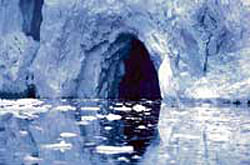Antartic summer ice melt is now occurring 10 times faster than it did 600 years ago, with ice loss speeding up the most since mid 20th Century, new research has warned.
The 1000-year Antarctic Peninsula climate reconstruction published in the journal Nature Geoscience, shows that summer ice melting has intensified almost 10-fold, and mostly since the mid 20th Century.
Summer ice melt affects the stability of Antarctic ice shelves and glaciers.
In 2008, a UK-French science team drilled a 364-metre long ice core from James Ross Island, near the northern tip of the Antarctic Peninsula, to measure past temperatures in the area.
They discovered that this ice core could also give a unique and unexpected insight into ice melt in the region.
Visible layers in the ice core indicated periods when summer snow on the ice cap thawed and then refroze.
By measuring the thickness of these melt layers the scientists were able to examine how the history of melting compared with changes in temperature at the ice core site over the last 1,000 years.
"We found that the coolest conditions on the Antarctic Peninsula and the lowest amount of summer melt occurred around 600 years ago," said lead author Dr Nerilie Abram of The Australian National University and British Antarctic Survey (BAS).
"At that time temperatures were around 1.6 degrees Celsius lower than those recorded in the late 20th Century and the amount of annual snowfall that melted and refroze was about 0.5 per cent. Today, we see almost ten times as much (5 per cent) of the annual snowfall melting each year," Abram said.
"Summer melting at the ice core site today is now at a level that is higher than at any other time over the last 1000 years. And whilst temperatures at this site increased gradually in phases over many hundreds of years, most of the intensification of melting has happened since the mid-20th century," Abram said in a statement.
This is the first time it has been demonstrated that levels of ice melt on the Antarctic Peninsula have been particularly sensitive to increasing temperature during the 20th century.
"What that means is that the Antarctic Peninsula has warmed to a level where even small increases in temperature can now lead to a big increase in summer ice melt," Abram said.
"Having a record of previous melt intensity for the Peninsula is particularly important because of the glacier retreat and ice shelf loss we are now seeing in the area," said Dr Robert Mulvaney, co-author of the paper.
"Summer ice melt is a key process that is thought to have weakened ice shelves along the Antarctic Peninsula leading to a succession of dramatic collapses, as well as speeding up glacier ice loss across the region over the last 50 years," he said.
